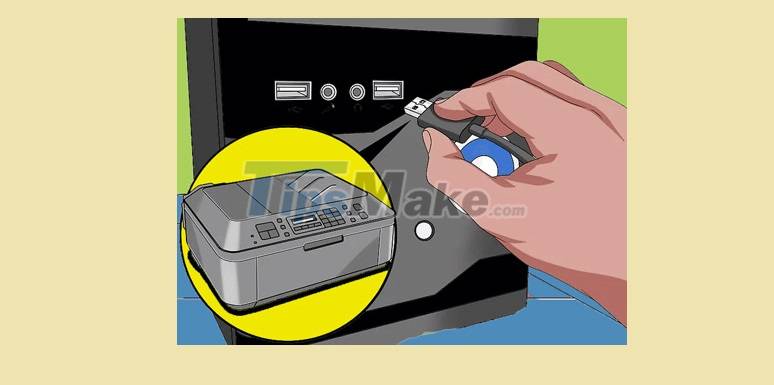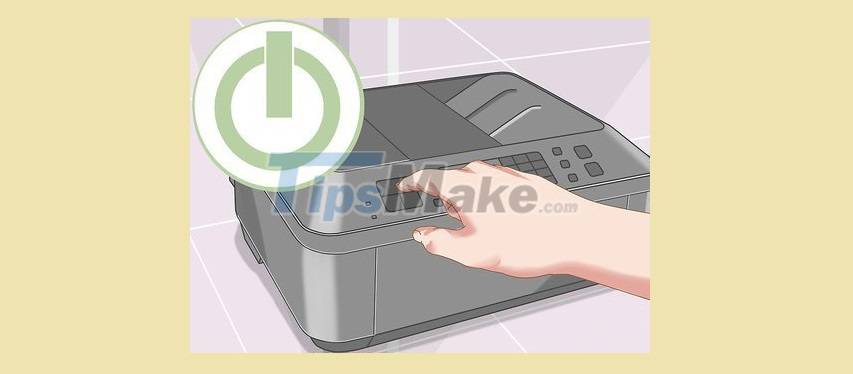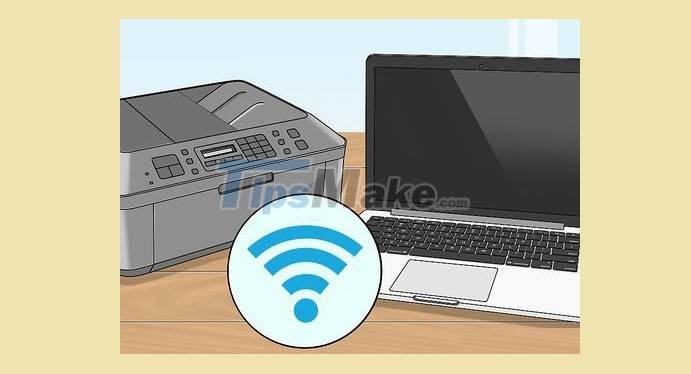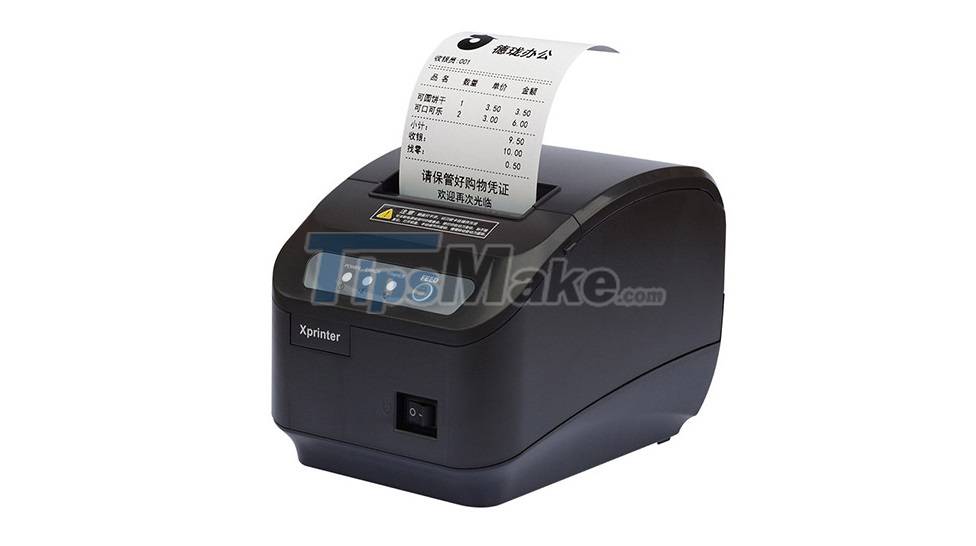Steps to connect the printer to the computer
While in the past offices used to share a single, centrally located printer, now a variety of connections allow users to access a small desktop USB printer and You can also connect to separate black and white or color printers without installing separate print servers.
1. Connect the printer to the computer via USB cable
Most smaller printers connect directly to a computer via the Universal Serial Bus (USB) standard. Connections using this standard are small, lightweight and universal - available on Windows, Macintosh and Linux computers. Furthermore, because the USB connection is bidirectional, it allows the printer to send data such as ink levels back to the computer.
Note: Please install the printer driver and other necessary software before connecting the printer to the computer with a USB cable.
Step 1: Make sure the printer is turned off before connecting the USB cable.
Step 2: Connect the printer end of the USB cable to the USB port on the side of the printer.
Note: The location of the USB port varies depending on the printer.

Step 3: Connect the other end of the USB cable to the USB port on the computer.
Step 4: Turn on the printer by pressing the power button.

Step 5: Load paper and print.
2. Connect the printer via Ethernet
Higher-end printers often have a built-in wired Ethernet connection for use with a local area network (LAN). Along with the LAN connection, they often contain a built-in print server. This allows other computers on the network to connect directly to the printer without connecting to another computer acting as a controller.
3. Connect the printer via WiFi

Printers with built-in WiFi network connectivity offer the same benefits as Ethernet-equipped devices, with one key difference. Since they connect to a wireless network, they can be placed anywhere without the need for a physical network connection jack. This makes them an especially good choice for workgroups that need a printer they can share while working together, but will eventually move elsewhere at the end of the project.
4. Share another computer's printer
Printers that are not built-in to a network can still be shared on a network through the printer sharing tools built into most operating systems. In this case, the printer connects to the computer via USB, and then the computer shares the printer over the network. While this can be an effective way to share a printer that is not connected to the network, it only works if the computer is always on and connected to the network.
5. Connect via old-fashioned ports

Some printers connect via legacy ports, like parallel and serial ports. Although modern printers no longer use parallel connections, some specialized printers, such as bill payment printers, still connect via RS-232C, using the 9-pin serial standard. Computers lacking a serial or parallel port can connect to these types of printers via a USB-to-parallel or USB-to-serial adapter.
You should read it
- Instructions for renaming the printer on Windows 10
- These are the types of printer cables needed to connect to the computer
- How to share a printer via LAN
- Instructions on how to fix the error of the computer not recognizing the printer
- Instructions on how to connect the printer to a laptop
- Instructions for fixing the error 'Windows cannot connect to the printer'
- How to Connect a USB Printer to a Network
- How to Connect Printer to Computer, Macbook Extremely Easy at Home
May be interested
- 2 steps to connect printer via Wifi network
 for small offices, connecting too many wired devices is always a big obstacle, making them unsightly and unprofessional. connecting the printer via wifi is the solution for you.
for small offices, connecting too many wired devices is always a big obstacle, making them unsightly and unprofessional. connecting the printer via wifi is the solution for you. - How to Set Up a Canon Wireless Printer
 today's tipsmake will show you how to connect and set up a canon wireless printer with a windows or mac computer. you can do this by connecting via the internet, connecting the printer to your computer via a usb cable, or allowing the printer to install and connect itself.
today's tipsmake will show you how to connect and set up a canon wireless printer with a windows or mac computer. you can do this by connecting via the internet, connecting the printer to your computer via a usb cable, or allowing the printer to install and connect itself. - How to share a printer via Lan network - So that 2 or more computers can print at the same time
 tipsmake.com will guide you how to share a printer via a local lan so that multiple computers can print documents. the article has 2 steps, 1 is to share the printer with another device and 2 is to connect to the shared printer.
tipsmake.com will guide you how to share a printer via a local lan so that multiple computers can print documents. the article has 2 steps, 1 is to share the printer with another device and 2 is to connect to the shared printer. - Fix error 0x00000709, 0x00000040, 0x0000011b when sharing printer in LAN simply with 2 steps
 while connecting to a shared printer from a computer in the lan, if you encounter error 0x00000709, 0x00000040, 0x0000011b when trying to connect to the shared printer.
while connecting to a shared printer from a computer in the lan, if you encounter error 0x00000709, 0x00000040, 0x0000011b when trying to connect to the shared printer. - Instructions for fixing the error 'Windows cannot connect to the printer'
 a shared printer for multiple pcs is a very common thing in an office environment. however, a very common error that interferes with the printing process is 'windows cannot connect to the printer'. in the following article, phong vu would like to share with readers about 5 ways to fix the error that cannot connect to the above printer.
a shared printer for multiple pcs is a very common thing in an office environment. however, a very common error that interferes with the printing process is 'windows cannot connect to the printer'. in the following article, phong vu would like to share with readers about 5 ways to fix the error that cannot connect to the above printer. - How to Connect a USB Printer to a Network
 today's tipsmake will show you how to connect a usb printer to the network via a router or print server. if the router has a usb port, it can be connected directly to the printer. you will need to configure the router to act as the printer server. if the router does not have a usb port or does not support a printer, we can buy an external print server and connect to the router via wire or wi-fi.
today's tipsmake will show you how to connect a usb printer to the network via a router or print server. if the router has a usb port, it can be connected directly to the printer. you will need to configure the router to act as the printer server. if the router does not have a usb port or does not support a printer, we can buy an external print server and connect to the router via wire or wi-fi. - Instructions for installing Canon LBP 2900 printer on Windows
 the operation of installing canon lbp 2900 printer on a computer with different operating systems is relatively simple. users only need to connect the printer to the computer and then connect to the internet and the computer will automatically download the appropriate driver.
the operation of installing canon lbp 2900 printer on a computer with different operating systems is relatively simple. users only need to connect the printer to the computer and then connect to the internet and the computer will automatically download the appropriate driver. - How to connect printer 2.0 USB port to USB 3.0 port on Windows 10
 the following article will guide you how to connect the usb 2.0 port of the printer to the usb 3.0 port on your computer. if you are having a similar problem, try it now!
the following article will guide you how to connect the usb 2.0 port of the printer to the usb 3.0 port on your computer. if you are having a similar problem, try it now! - Instructions on how to connect the printer to a laptop
 the way to connect the printer to a laptop is no different to a desktop computer. but with wired and wireless printers, windows and mac computers will be different.
the way to connect the printer to a laptop is no different to a desktop computer. but with wired and wireless printers, windows and mac computers will be different. - Instructions to fix windows cannot connect to the printer error
 during the process of adding a printer to the network, sometimes you may receive a windows cannot connect to the printer error message on the screen.
during the process of adding a printer to the network, sometimes you may receive a windows cannot connect to the printer error message on the screen.









 Should I buy a Canon or Brother printer?
Should I buy a Canon or Brother printer? What is the size of A9 paper? How to select and print A9 paper in Word
What is the size of A9 paper? How to select and print A9 paper in Word How to fix the printer not receiving print job on the computer
How to fix the printer not receiving print job on the computer Error Excel does not recognize printer - Cause and effective remedy
Error Excel does not recognize printer - Cause and effective remedy Instructions on how to fix the error of the computer not recognizing the printer
Instructions on how to fix the error of the computer not recognizing the printer Printer error not receiving print job - Cause and effective remedy
Printer error not receiving print job - Cause and effective remedy